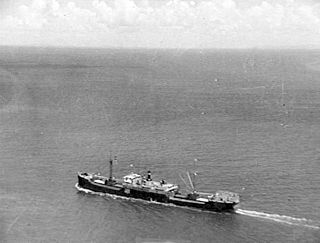Related Research Articles

A steamship, often referred to as a steamer, is a type of steam-powered vessel, typically ocean-faring and seaworthy, that is propelled by one or more steam engines that typically move (turn) propellers or paddlewheels. The first steamships came into practical usage during the early 1800s; however, there were exceptions that came before. Steamships usually use the prefix designations of "PS" for paddle steamer or "SS" for screw steamer. As paddle steamers became less common, "SS" is assumed by many to stand for "steamship". Ships powered by internal combustion engines use a prefix such as "MV" for motor vessel, so it is not correct to use "SS" for most modern vessels.

A steamboat is a boat that is propelled primarily by steam power, typically driving propellers or paddlewheels. Steamboats sometimes use the prefix designation SS, S.S. or S/S or PS ; however, these designations are most often used for steamships.

A brig is a type of sailing vessel defined by its rig: two masts which are both square-rigged. Brigs originated in the second half of the 18th century and were a common type of smaller merchant vessel or warship from then until the latter part of the 19th century. In commercial use, they were gradually replaced by fore-and-aft rigged vessels such as schooners, as owners sought to reduce crew costs by having rigs that could be handled by fewer men. In Royal Navy use, brigs were retained for training use when the battle fleets consisted almost entirely of iron-hulled steamships.

SS Savannah was an American hybrid sailing ship/sidewheel steamer built in 1818. She was the first steamship to cross the Atlantic Ocean, transiting mainly under sail power from May to June 1819. In spite of this historic voyage, the great space taken up by her large engine and its fuel at the expense of cargo, and the public's anxiety over embracing her revolutionary steam power, kept Savannah from being a commercial success as a steamship. Originally laid down as a sailing packet, she was, following a severe and unrelated reversal of the financial fortunes of her owners, converted back into a sailing ship shortly after returning from Europe.

A paddle steamer is a steamship or steamboat powered by a steam engine that drives paddle wheels to propel the craft through the water. In antiquity, paddle wheelers followed the development of poles, oars and sails, where the first uses were wheelers driven by animals or humans.

Captain Robert Bennet Forbes, was an American sea captain, China merchant and ship owner. He was active in ship construction, maritime safety, the opium trade, and charitable activities, including food aid to Ireland, which became known as America's first major disaster relief effort.

The Age of Sail is a period that lasted at the latest from the mid-16th to the mid-19th centuries, in which the dominance of sailing ships in global trade and warfare culminated, particularly marked by the introduction of naval artillery, and ultimately reached its highest extent at the advent of the analogue Age of Steam. Enabled by the advances of the related Age of Navigation, it is identified as a distinctive element of the early modern period and the Age of Discovery. Especially in context of the latter, it refers to a more particular Eurocentric Age of Sail, while generally the Age of Sail is the culminating period of a long intercontinental history of sailing.

Iron-hulled sailing ships represented the final evolution of sailing ships at the end of the age of sail. They were built to carry bulk cargo for long distances in the nineteenth and early twentieth centuries. They were the largest of merchant sailing ships, with three to five masts and square sails, as well as other sail plans. They carried lumber, guano, grain or ore between continents. Later examples had steel hulls. They are sometimes referred to as "windjammers" or "tall ships". Several survive, variously operating as school ships, museum ships, restaurant ships, and cruise ships.

SS Pacific was a wooden sidewheel steamer built in 1850 most notable for its sinking in 1875 as a result of a collision southwest of Cape Flattery, Washington. Pacific had an estimated 275 passengers and crew aboard when she sank. Only two survived. Among the casualties were several notable figures, including the vessel's captain at the time of the disaster, Jefferson Davis Howell (1846–1875), the brother-in-law of former Confederate President Jefferson Davis. The sinking of Pacific killed more people than any other marine disaster on the West Coast at the time.

The steamboat Enterprise demonstrated for the first time by her epic 2,200-mile (3,500 km) voyage from New Orleans to Brownsville, Pennsylvania that steamboat commerce was practical on the Mississippi River and its tributaries.

The Baltimore Steam Packet Company, nicknamed the Old Bay Line, was an American steamship line from 1840 to 1962 that provided overnight steamboat service on Chesapeake Bay, primarily between Baltimore, Maryland, and Norfolk, Virginia. Called a "packet" for the mail packets carried on government mail contracts, the term in the 19th century came to mean a steamer line operating on a regular, fixed daily schedule between two or more cities. When it closed in 1962 after 122 years of existence, it was the last surviving overnight steamship passenger service in the United States.

MS West Honaker was a diesel-powered cargo ship of the United States Maritime Commission (USMC) that was part of the "Corncob Fleet" of old ships sunk as part of the "gooseberry" breakwater off Utah Beach during the Normandy invasion. The ship was originally built as SS West Honaker, a steam-powered cargo ship built for the United States Shipping Board (USSB), a predecessor of the USMC. At the time of her completion in 1920, the ship was inspected by the United States Navy for possible use as USS West Honaker (ID-4455) but was neither taken into the Navy nor ever commissioned under that name.

Packet boats were medium-sized boats designed for domestic mail, passenger, and freight transportation in European countries and in North American rivers and canals, some of them steam driven. They were used extensively during the 18th and 19th centuries and featured regularly scheduled service.

Bristol was a large sidewheel steamboat launched in 1866 by William H. Webb of New York for the Merchants Steamship Company. One of Narragansett Bay's so-called "floating palaces", the luxuriously outfitted Bristol and her sister ship Providence, each of which could carry up to 1,200 passengers, were installed with the largest engines then built in the United States, and were considered to be amongst the finest American-built vessels of their era.

SS Archimedes was a steamship built in Britain in 1839. She was the world's first steamship to be driven successfully by a screw propeller.

Steam-powered vessels include steamboats and steamships. Smaller steamboats were developed first. They were replaced by larger steamships which were often ocean-going. Steamships required a change in propulsion technology from sail to paddlewheel to screw to steam turbines. The latter innovation changed the design of vessels to one that could move faster through the water. Engine propulsion changed to steam turbine in the early 20th century. In the latter part of the 20th century, these, in turn, were replaced by gas turbines.

Corvus was a steam cargo ship built in 1919 by Columbia River Shipbuilding Company of Portland for the United States Shipping Board as part of the wartime shipbuilding program of the Emergency Fleet Corporation (EFC) to restore the nation's Merchant Marine. The freighter was operated on international and domestic routes through 1944. Early in 1945 she was transferred to Soviet Union as part of lend-lease program and renamed Uzbekistan. After several months of operation, the freighter was rammed by another vessel on 31 May 1945 and was beached to avoid sinking. She was subsequently raised and towed to Portland where she was scrapped in 1946.


Star of the South was a wooden-hulled, propeller-driven steamship launched in 1853. She was one of the first mechanically reliable and economically profitable propeller-driven steamships. Her success foretold the end of paddlewheel propulsion on ocean-going steamships.
The Havre Second Line was a business organization that provided packet service between the Ports of New York and Le Havre, France. William A. Fairburn identified four characteristics of a packet service. (1) a regular line between ports; (2) ships operating exclusively in the service; (3) common ownership of the operating ships and associated facilities by individuals, a partnership, or a corporation; and (4) regular sailing on a specified day of a certain month.
References
- 1 2 3 4 5 Rogers, Brian (Spring 2019). "SS Savannah: The Bicentennial of Her Historic Voyage". PowerShips. Warwick, R.I.: Steamship Historical Society of America.
- 1 2 3 4 Braynard, Frank O. (Spring 2019). "The Savannah: Illustrious Failure". PowerShips. Warwick, R.I.: Steamship Historical Society of America.